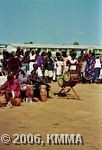

The dundun is a closed double-headed cylindrical wooden drum with a laced
membrane. The dundun drum was adopted from the Mande from Mali. This set of
drums used to be one of the royal drums of the Mande and the Wolof from
Senegal, but now they are found in Mali and in the area along the upper
reaches of the Gambia river. It then spread along the costal regions of West
Africa.
In the literature, the dundun is referred to as: "dunun, djun
djun, djoundjoung, doundoun and doundounba".
The dundun is one of a set of three drums, of which it is the largest,
besides the medium-sized sanbeni (sangba) and the kenkeni,
the narrowest of the ensemble.
The dundun can be made of wood (cedar, walnut or any other hardwood) or of
metal. The drum shell of a metal dundun is a sawn-off cylindrical barrel. The
three drums are placed horizontally in an X-shaped stand to support the drums
during play.
The dundun is approximately 65 cm long and has a diameter of 40 to 50
cm. The membrane is either goat or cow hide. The two membranes are tied to
each other along the sides with a system of interlaced ropes. The dundun drum
is a bass drum and has a low full sound.
The sanbeni is slightly smaller than the djun djun and is approximately 40 to 50 cm long with a diameter of approximately 30 to 35 cm. The musician plays syncopated rhythms and creates poly rhythmical structures in the middle register of the drum ensemble.
The kenkeni is the narrowest of the three drums, measuring around 30 to 40 cm in length with a diameter of 25 cm. It has a high clear sound. A metal bell is attached to the drum shell of the kenkeni to allow the drummer to play an extra rhythm.
The dundun set is played with a large wooden drumstick. The drummer
strikes the membrane on one side of the drum with a drumstick while he damps
the membrane on the other side with the palm or fingertips.
The dundun is used to accompany dancing, sometimes in combination with
the djembe.
© RMCA/Dominik PHYFFEROEN